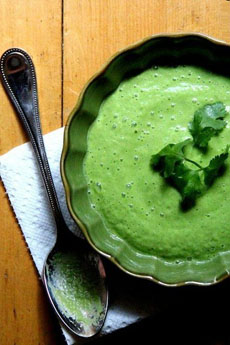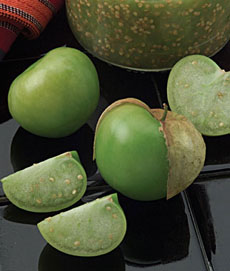|

Stack slices of grilled polenta with your favorite fillings; here, crab salad and guacamole (photo © Costanero Cocoino Peruana).
|
|
Polenta—which is both the Italian word for cornmeal and a cooked dish made from it—has become popular in America through Italian and Continental restaurants. But it’s not new to America. For the first two centuries of The United States, American diets contained much cornmeal—in bread, breakfast cereal and other recipes. It was gradually replaced by refined wheat flour.
While corn itself is a whole grain, polenta is refined: It is degerminated cornmeal, with the germ and endosperm (which contain the fiber and other nutrition) removed. As with all refined grains——the majority of the grains we consume—the protein, iron and vitamins are left on the factory floor.
But that doesn’t mean it isn’t a delicious addition to the table. We spotted this attractive starter at Costanero Cocoino Peruana, a Peruvian restaurant in Montclair, New Jersey. It reminded us of Caprese stacks, one of our favorite first courses to make with summer’s heirloom tomatoes (see photo below).
You can make polenta from scratch, or buy it in rolls, available in most supermarkets. The latter makes it easy to create stacked appetizers and sides. It’s available in plain plus flavors such as basil-garlic and sundried tomato.
|
|
STACKED POLENTA APPETIZER RECIPE
The most time-consuming part of this recipe is deciding what to layer in-between the polenta slices. Tips: Select different colors, and check out your leftovers to see what could work. You can serve the stacks with a lightly-dressed frisée or mesclun salad.
Ingredients
Polenta, three slices per serving
Pesto, remoulade, thousand island dressing or other sauce for garnish (match sauce to fillings)
Optional: fresh herbs for garnish
Then, select two fillings:
Bacon, crumbled (variation: bacon and onions cooked in the bacon fat) or prosciutto
Carrot salad
Cheese: goat cheese, mozzarella or other favorite, preferably soft or semisoft
Crab, shrimp or other protein salad, finely chopped
Cranberry sauce or chutney
Giardiniera or marinated chopped vegetables
Guacamole or vegetable puree (broccoli, pea, red bell pepper or anything colorful)
Chicken, ham, turkey or other protein, diced (a great use for leftovers)
Herb-marinated mushrooms, finely chopped
Mashed potatoes—update the flavor with fresh chives, basil, or flavored olive oil
Sautéed or steamed spinach or kale, seasoned with garlic
Smoked salmon or other smoked fish
Spread of any kind
Anything else that appeals to you
|
|
Preparation
1. SLICE polenta into desired thickness. Broil, fry or grill until edges become slightly crisp.
2. TOP first polenta round with first filling and top with second polenta round. Use a spatula to make the filling flush with the edges of the polenta. Repeat with second filling and third polenta round.
3. PLATE as desired, with pesto/sauce, fresh herbs and/or salad.
MORE RECIPES
There are two styles of polenta: creamy polenta, which is like cooked grits, and sliced polenta, in rounds or squares/rectangles. These recipes use rounds from purchased rolls of polenta. Start by slicing and grilling/frying the rounds.
Breakfast
With maple syrup or topped with a fried egg.
“Huevos rancheros” style, topped with cheese, a poached egg and salsa.
|
|

A vertical Caprese salad: tomatoes, mozzarella and basil. You can grow the beautiful opal [purple] basil here with seeds from BonniePlants.com, or buy it at a farmer’s market (photo © Bonnie Plants).
|
Lunch, Dinner Or Sides
With tomato sauce and cubed or grated cheese. Layer fried slices in a baking dish, top with sauce and cheese and bake until cheese melts (some people call this “gnocchi alla romana”). You can add sliced or crumbled sausage.
Topped with mushroom ragu.
On a bed of sautéed bell peppers, mushrooms and onions.
Topped with any kind of sauce or mix of leftovers: cubed ham, capers, whatever.
“Hash browns” or fries: Cut roll into fry-size planks, fry and dust them with grated parmesan.
Breaded, fried and served with pesto or a dipping sauce.
MORE POLENTA IDEAS
Polenta cookies (recipe)
Ratatouille With Crispy Polenta (recipe)
Smoked paprika Shrimp With Poblano Polenta (recipe)
|
|







